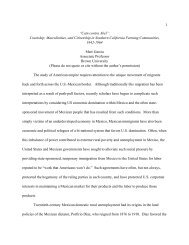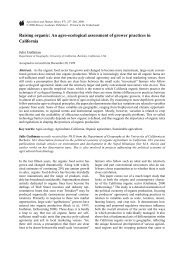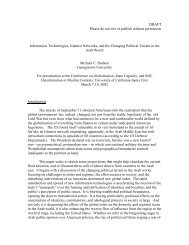The Death of Ramon Gonzalez and the 21st Century Dilemma
The Death of Ramon Gonzalez and the 21st Century Dilemma
The Death of Ramon Gonzalez and the 21st Century Dilemma
You also want an ePaper? Increase the reach of your titles
YUMPU automatically turns print PDFs into web optimized ePapers that Google loves.
on <strong>the</strong> Mexican rural economy as well making some Mexican agricultural commodities<br />
more competitive in U.S. markets. Most <strong>of</strong> <strong>the</strong> tariff reductions have now been made.<br />
However, in blatant disregard <strong>of</strong> <strong>the</strong> agreements made, <strong>the</strong> United States<br />
subsequently passed <strong>the</strong> largest farm subsidy program in history, <strong>and</strong> <strong>the</strong> subsidies<br />
largely go to grain farmers. In some areas <strong>of</strong> <strong>the</strong> Midwest, grain farmers receive more<br />
than half, <strong>and</strong> in some counties up to eighty percent, <strong>of</strong> <strong>the</strong>ir income from government<br />
subsidies. Iowa received $11.2 billion <strong>of</strong> federal crop subsidies from 1995 to 2003, most<br />
<strong>of</strong> it going to corn farmers. (<strong>The</strong> distribution <strong>of</strong> subsidies—with about ten percent <strong>of</strong> <strong>the</strong><br />
largest farm operations receiving more than seventy percent <strong>of</strong> <strong>the</strong> subsidies—tends to<br />
widen <strong>the</strong> gap between <strong>the</strong> rich <strong>and</strong> <strong>the</strong> poor <strong>and</strong> penalize small farmers within <strong>the</strong> United<br />
States, as well as across borders.) vii<br />
<strong>The</strong> combined results <strong>of</strong> <strong>the</strong> NAFTA agreement <strong>and</strong> <strong>the</strong> continued subsidization<br />
<strong>of</strong> U.S. grain producers are now being felt, after a delay caused both by <strong>the</strong> phase-in<br />
period <strong>and</strong> by <strong>the</strong> peso crisis <strong>of</strong> 1994 that for a time significantly raised <strong>the</strong> price <strong>of</strong> U.S.<br />
imports to Mexico <strong>and</strong> made Mexican exports more attractive. By <strong>the</strong> end <strong>of</strong> <strong>the</strong> century,<br />
U.S. corn exports to Mexico began to rise rapidly.<br />
No firm numbers are available because it is difficult to isolate any single factor in<br />
<strong>the</strong> multiple reasons that Mexicans continue to leave <strong>the</strong>ir l<strong>and</strong> <strong>and</strong> communities, but it is<br />
reasonable to believe that 1.3 million Mexican rural families have left <strong>the</strong> l<strong>and</strong> due to <strong>the</strong><br />
effects <strong>of</strong> NAFTA <strong>and</strong> Article 27 reforms viii . As a result both <strong>of</strong> <strong>the</strong> increasing<br />
desperation <strong>of</strong> more Mexicans to cross <strong>the</strong> border <strong>and</strong> tightened border security, <strong>the</strong> direct<br />
toll on Mexican migrants has been severe. It has been harder to return to Mexico to





